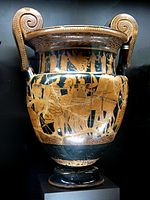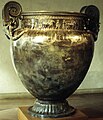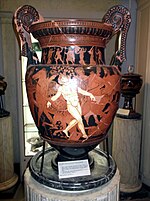Volute crater
The volute crater , called κρατὴρ λακωνικός (lakonikos crater) in ancient Greece , is a type of the Greek wine mixing vessel crater . It is one of the four standard types of crater; he was in the first quarter of the 6th century BC. Invented in Laconia . Later, volute craters were made in Attica and Apulia , where independent styles developed. During its lifetime of almost three centuries, the volute crater was subject to major changes, so that only the principle of the handle construction is the defining feature of this type of crater.
Name and defining characteristics
The volute crater got its modern name from the handles ending in a volute . In accordance with its origin, it was called κρατὴρ λακωνικός (crater lakonikos) in ancient Greece, although it was also produced elsewhere.
The volute crater was changed significantly during its lifetime. In the Apulian volute craters of the late classical period, the volute is usually not formed, a disc adorned with a mask only suggests it. As a defining feature, the basic handle shape can be retained across all forms: The handle is made up of two parts and, like the bow handle crater , consists of a horizontal and a vertical element. At the horizontal part of the handle, the handle arch, a vertical part of the handle is attached, which, unlike the other craters, extends beyond the mouth of the vessel and then leads back to it. On the vertical part of the handle, there is always a middle part, the handle band, and panels on both sides, the handle beads. Seen from the handle side, the handle band appears to be recessed against the handle bulges, while from the front side only the front-faded handle bulge can be seen on each of the two handles of a crater.
role models
The following statements about the models of the volute crater were made on the basis of very few finds. Two completely preserved vases from Boeotia and Laconia, which are in Boston and Sparta, are of particular importance .
Origin of the handle shape
If one disregards the very early occurrence of volute-like curved handle shapes in vases, which are neither in spatial nor in temporal continuity with the volute crater, the origin of volute-shaped handles can be sought in the relief pithoi from Tinos and Boeotia. When filled, these pithoi were too heavy to be carried by the handles. The space between the now functionless handle and the vase wall could be filled with a clay disc decorated with spirals, which made it a purely decorative element. In the relief vases later made in Laconia, this basic principle was adopted and further developed, whereby the clay disc was reduced in size and the handle became accessible again. The two-part design of the handle with a horizontal and vertical element can be derived from the geometric bow handle craters. The so-called Chalcidian type , the handles of which also have horizontal and vertical parts, are more recent.
Previous craters
The shape of the volute crater with its low neck, bulbous body and clearly offset foot is attributed to the influence of the colonic crater .
The laconic relief vessels , the handles of which can be seen as the forerunners of the volute crater handles, are often referred to in the literature as pithoi , but can also be interpreted as craters due to their wide mouth opening. The low height of about 70 cm and the circumstances of the discovery of these vessels speak against the interpretation as pithoi, which primarily suggest a dedication as a consecration gift. In addition to the volute decoration of the handle, the laconic relief vessels have other similarities with the bronze volute craters from Laconia, so that they can be described as their predecessors. These similarities are, on the one hand, a three-tiered neck profile and, on the other hand, the distribution of the decorative elements : spirals on the handles and tongues below the mouth, on the shoulder and foot. The common theme of the chariot train of both types of vessels can be seen as a further indication of the dependence of the volute crater on the laconic relief vases; it is common, but only found on these two types of vases in laconic art.
Development, manufacturing landscapes
The first volute craters were made around 575 BC. Made of bronze in Laconia. These vases were very soon copied in other parts of Greece. In Laconia, ceramic volute craters were created around the same time as the bronze ones. However, these craters do not follow the tradition of the relief vessels, but leave some of the typical features, such as the tongue motif at the mouth and the three-tiered neck profile, and form a tradition of their own. The volute is also not formed, but replaced by a flat disc (Rotelle), although the volute of the metal version would have been easy to take over, for example by means of spiral-shaped incisions. The horizontal handle is made in the second half of the 6th century BC. Replaced by a supporting Gorgon - an innovation that can be traced back to laconic workshops. Before the end of the 6th century BC BC the popularity of this decorative element dwindles.
The first imitations of the volute crater were made in Ionia, a bronze handle in the Berlin Collection of Antiquities is considered the oldest witness of these imitations and is attributed to a workshop on Samos . Early imitations of the bronze laconic volute crater also come from Corinth or its vicinity. From these, the imitations adopted the three-step neck profile. The decoration and pictorial themes of the imitations are different from those of the laconic craters. The handles are consistently more simply cast than their models; a free rotation of the volute in laconic handles contrasts with a purely ornamental hint of the spiral in the pieces from the rest of Greece.
Attic potters imitated the laconic volute crater of the bronze version, adhering closely to the model and thus distinguishing their products from the laconic ceramics. A steady production of ceramic volute craters in Attic workshops begins between 540 and 530 BC. The metal luster of the model was imitated by black varnish . The shape of the Attic volute crater begins with various innovations in the time of black-figure vase painting . Most examples of the Attic black-figure style volute crater were made in the last two decades of the 6th century BC. Manufactured.
With the onset of red-figure vase painting , further innovations appear; until the second half of the fifth century BC The changes lead to a canonical style . The production of Attic red-figure volute craters is started at the beginning of the fourth century BC. Chr. Set.
Bronze craters took the place of the Attic clay vessels. There are no bronze volute craters from the time between 500 BC. BC and 430 BC Known, the assumption of continuous production is suggested by the correspondence of certain details of the bronze craters from late Classical with details of the bronze non-laconic volute craters from archaic production. In the late Classical pieces, in contrast to the archaic imitations of the laconic volute crater, the volute is freely rotated, so that at least one development must be assumed in the time without finds.
Already in the last third of the fifth century BC Ceramic volute craters were also produced in Apulia ; After adopting elements of the bronze craters at the same time and replacing the volutes with mask-like discs, a canonical Apulian style of volute crater emerged. Both bronze and ceramic volute craters were still in use until the end of the fourth century BC. Manufactured.
According to material, origin and manufacturing period, the following groups of volute craters are to be distinguished: Laconic bronze craters, laconic clay craters, archaic imitations of the laconic bronze craters from the rest of Greece, Attic clay craters (black-figure and red-figure), late classical bronze craters and Apulian clay craters.
use
The find conditions of laconic volute craters give little information about their use in Greece. Laconic bronze volute craters were only found outside Greece, and only a few fragments of the clay fragments were found in Greece, the sites of which indicate that they were used as gifts of consecration to the gods.
However, depictions of volute craters on other laconic vases indicate a use for mixing wine, also at the symposium . Further references are preserved sieves, representations of sieves and the mention of a sieve for a laconic volute crater in an antique inventory. That symposia were celebrated in Sparta at all, is evident from the songs of Alkman .
In contrast to the laconic volute craters made of bronze, finds of the Attic clay version are common within Greece. The circumstances of the find indicate that it was primarily used as a consecration gift. Volute craters were not used as grave goods in Attica itself, rarely in the rest of the Greek heartland, but often in the colonies in Sicily and Apulia . Finds in a domestic context suggest that Attic volute craters were also used to mix wine. Attic vase pictures indicate a use of the volute crater in Dionysian celebrations. In black-figure representations, the volute crater is the center of the celebration, but without being drawn from it. The volute crater is also used to draw on red-figure pictures. About 480 BC In Chr. Volute craters are hardly represented as a mixing vessel. It can be assumed that the practical use of the volute crater will be pushed back from this time in favor of the purely cultic function and will eventually disappear completely.
Famous volute crater
- The crater of Vix , a laconic bronze crater, 164 cm high and of particular size, was found in a princely grave that belongs to a Celtic settlement near the village of Vix near Châtillon-sur-Seine .
- The François vase , also known as Klitias crater, an Attic black-figure volute crater, was made by the potter Ergotimos and the painter Klitias .
- On the Attic Talos crater , the name vase of the Talos painter , the bow of Argo , Jason , Talos and other actors of the Argonaut legend are depicted in red-figure style ; the crater was found in the Apulian Ruvo necropolis .
- The Derveni crater is 94 cm high and 40 kg weight, a particularly large and magnificent late classical bronze crater with silver inlays; it comes from grave B of Derveni in Macedonia .
- The Lasimos crater is an Apulian volute crater of great importance for research into Lower Italian vase painting .
- The Perservase , a 130 cm high Apulian volute crater, is the name vase of the Darius painter .
literature
- Konrad Hitzl : The origin and development of the volute crater from the earliest beginnings to the expression of the canonical style in Attic black-figure vase painting . Lang, Frankfurt am Main / Bern 1982, ISBN 3-8204-7288-6 (= Archaeological Studies, Volume 6, also dissertation at the University of Mainz 1982).
- Hannelore Eva Schleiffenbaum: The Greek volute crater. Form, function and meaning of an ancient magnificent vessel . Lang, Frankfurt am Main 1991, ISBN 3-631-43477-4 (= European university publications , series 38, archeology, volume 36, also dissertation at the University of Munich 1989; with a catalog of 372 finds from volute craters).
Web links
Individual evidence
- ↑ Andreas Rumpf : Lakonikos crater. In: Charites. Festschrift E. Langlotz. Bonn 1957, pp. 127-135.
- ↑ Hannelore Eva Schleiffenbaum: The Greek volute crater. Peter Lang, Frankfurt am Main 1991, ISBN 3-631-43477-4 , p. 15; the designations of the handle parts go to Konrad Hitzl: The origin and development of the volute crater from the earliest beginnings to the expression of the canonical style in Attic black-figure vase painting . Peter Lang, Frankfurt am Main 1982, ISBN 3-8204-7288-6 , p. Iii back.
- ↑ Konrad Hitzl: The origin and development of the volute crater from the earliest beginnings to the expression of the canonical style in Attic black-figure vase painting . Peter Lang, Frankfurt am Main 1982, ISBN 3-8204-7288-6 , pp. 4-14.
- ↑ Konrad Hitzl: The origin and development of the volute crater from the earliest beginnings to the expression of the canonical style in Attic black-figure vase painting . Peter Lang, Frankfurt am Main 1982, ISBN 3-8204-7288-6 , pp. 16, 30, 36
- ↑ Konrad Hitzl: The origin and development of the volute crater from the earliest beginnings to the expression of the canonical style in Attic black-figure vase painting . Peter Lang, Frankfurt am Main 1982, ISBN 3-8204-7288-6 , pp. 17-18.
- ↑ Konrad Hitzl: The origin and development of the volute crater from the earliest beginnings to the expression of the canonical style in Attic black-figure vase painting . Peter Lang, Frankfurt am Main 1982, ISBN 3-8204-7288-6 , p. 30.
- ↑ First of Fernand Courby : Les vases grecs à reliefs , de Boccard, Paris 1922, and later by Georges Vallet and Francois Villard : Un atelier de bronziers: sur l'école du cratère de Vix. In: Bulletin de correspondance hellénique 79, 1955, pp. 66–67 Note 5 Digitalisat and Conrad M. Stibbe : Laconian black-glazed pottery 1: Laconian mixing bowls - a history of the krater Lakonikos from the seventh to the fifth century BC Allard Pierson Museum, Amsterdam 1989, ISBN 90-71211-16-9 .
- ↑ Hannelore Eva Schleiffenbaum: The Greek volute crater. Peter Lang, Frankfurt am Main 1991, ISBN 3-631-43477-4 , pp. 21, 100-104.
- ↑ Hannelore Eva Schleiffenbaum: The Greek volute crater. Peter Lang, Frankfurt am Main 1991, ISBN 3-631-43477-4 , p. 22. 36.
- ↑ Hannelore Eva Schleiffenbaum: The Greek volute crater. Peter Lang, Frankfurt am Main 1991, ISBN 3-631-43477-4 , pp. 25. 36 ff.
- ↑ Hannelore Eva Schleiffenbaum: The Greek volute crater. Peter Lang, Frankfurt am Main 1991, ISBN 3-631-43477-4 , p. 25 ff.
- ↑ Konrad Hitzl: The origin and development of the volute crater from the earliest beginnings to the expression of the canonical style in Attic black-figure vase painting . Peter Lang, Frankfurt am Main 1982, ISBN 3-8204-7288-6 , p. 36.
- ↑ Hannelore Eva Schleiffenbaum: The Greek volute crater. Peter Lang, Frankfurt am Main 1991, ISBN 3-631-43477-4 , p. 39. 95.
- ↑ Hannelore Eva Schleiffenbaum: The Greek volute crater. Peter Lang, Frankfurt am Main 1991, ISBN 3-631-43477-4 , pp. 43-44. 48-49.
- ↑ Konrad Hitzl: The origin and development of the volute crater from the earliest beginnings to the expression of the canonical style in Attic black-figure vase painting . Peter Lang, Frankfurt am Main 1982, ISBN 3-8204-7288-6 , pp. 43-83.
- ↑ Konrad Hitzl: The origin and development of the volute crater from the earliest beginnings to the expression of the canonical style in Attic black-figure vase painting . Peter Lang, Frankfurt am Main 1982, ISBN 3-8204-7288-6 , p. 40 ff.
- ↑ Hannelore Eva Schleiffenbaum: The Greek volute crater. Peter Lang, Frankfurt am Main 1991, ISBN 3-631-43477-4 , pp. 39-42.
- ↑ Hannelore Eva Schleiffenbaum: The Greek volute crater. Peter Lang, Frankfurt am Main 1991, ISBN 3-631-43477-4 , p. 51.
- ↑ Konrad Hitzl: The origin and development of the volute crater from the earliest beginnings to the expression of the canonical style in Attic black-figure vase painting . Peter Lang, Frankfurt am Main 1982, ISBN 3-8204-7288-6 , pp. 84-133.
- ↑ Hannelore Eva Schleiffenbaum: The Greek volute crater. Peter Lang, Frankfurt am Main 1991, ISBN 3-631-43477-4 , pp. 60-68.
- ↑ Hannelore Eva Schleiffenbaum: The Greek volute crater. Peter Lang, Frankfurt am Main 1991, ISBN 3-631-43477-4 , pp. 73-74.
- ↑ Hannelore Eva Schleiffenbaum: The Greek volute crater. Peter Lang, Frankfurt am Main 1991, ISBN 3-631-43477-4 , pp. 96-97.
- ↑ Hannelore Eva Schleiffenbaum: The Greek volute crater. Peter Lang, Frankfurt am Main 1991, ISBN 3-631-43477-4 , pp. 106-115.
- ↑ Hannelore Eva Schleiffenbaum: The Greek volute crater. Peter Lang, Frankfurt am Main 1991, ISBN 3-631-43477-4 , pp. 115-132, pp. 144-148.
- ↑ first monograph on volute crater, on this review by Dietrich von Bothmer , in Gnomon 57, 1985, pp. 66–71








